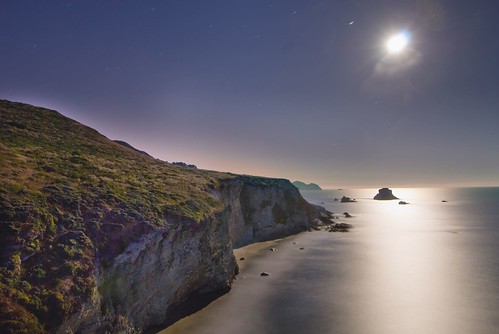At two minutes, this exposure was smack dab in the middle of the dynamic range for capturing bright moonlight. In other words, the exposure should be (and indeed was) “correct” with a roughly equal distribution of dark, middle, and light tonalities and appropriate rendering for each.
If you look closely, particularly in the larger size, you can see that this was a long exposure at night: witness the star trails. But in most ways the digital capture shows a scene with as much vivid detail as a daytime capture.
Other issues: I’m not sure how I feel about the optical artifacts (generated by the internals of my lens) around the moon. The moon is actually a more concentrated light source than the sun, you’d never see quite the targeted beam effect from sunlight. Moonlight is a bit lower in color temperature than sunlight, and you can see the difference on the hillside on the left. And the glow at the edge of the horizon from urban lights is a purely night phenomenon.
Here’s another image captured looking in the same direction from Arch Rock.
Related story: Taming Extravagant Dynamic Range.

daintree
20 Sep 2007Wow…
I’m just starting to get into photography. Got a Canon A640 at the moment. I hope to learn more and work up a proper SLR.
I really enjoy this website. It makes me see the world in a different way.. I think your photos show the subtle beautiful magic of this planet.
Thanks!